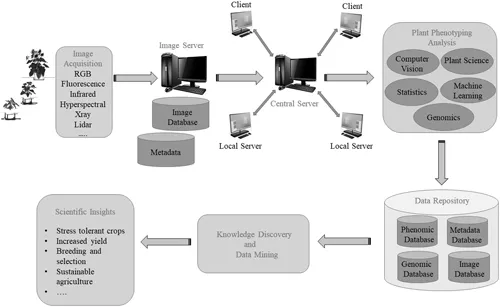
Intelligent Image Analysis for Plant Phenotyping
- 326 pages
- English
- ePUB (mobile friendly)
- Available on iOS & Android
Intelligent Image Analysis for Plant Phenotyping
About this book
Domesticated crops are the result of artificial selection for particular phenotypes or, in some cases, natural selection for an adaptive trait. Plant traits can be identified through image-based plant phenotyping, a process that was, until recently, strenous and time-consuming. Intelligent Image Analysis for Plant Phenotyping reviews information on time-saving techniques, using computer vision and imaging technologies. These methodologies provide an automated, non-invasive, and scalable mechanism by which to define and collect plant phenotypes. Beautifully illustrated, with numerous color images, the book focuses on phenotypes measured from individual plants under controlled experimental conditions, which are widely available in high-throughput systems.
Features:
- Presents methodologies for image processing, including data-driven and machine learning techniques for plant phenotyping.
- Features information on advanced techniques for extracting phenotypes through images and image sequences captured in a variety of modalities.
- Includes real-world scientific problems, including predicting yield by modeling interactions between plant data and environmental information.
- Discusses the challenge of translating images into biologically informative quantitative phenotypes.
A practical resource for students, researchers, and practitioners, this book is invaluable for those working in the emerging fields at the intersection of computer vision and plant sciences.
Frequently asked questions
- Essential is ideal for learners and professionals who enjoy exploring a wide range of subjects. Access the Essential Library with 800,000+ trusted titles and best-sellers across business, personal growth, and the humanities. Includes unlimited reading time and Standard Read Aloud voice.
- Complete: Perfect for advanced learners and researchers needing full, unrestricted access. Unlock 1.4M+ books across hundreds of subjects, including academic and specialized titles. The Complete Plan also includes advanced features like Premium Read Aloud and Research Assistant.
Please note we cannot support devices running on iOS 13 and Android 7 or earlier. Learn more about using the app.
Information
Part I
Basics
1 Image-Based Plant Phenotyping
1.1 Introduction
1.2 Importance of Phenotyping Research
1.3 Plant Phenotyping Analysis Framework

1.4 Plant Phenotyping Networks
Plant Phenotyping Networks around the World
| Network | Name | Web Location |
| APPF | Australian Plant Phenotyping Facility | http://www.plantphenomics.org.au/ |
| APPN | Austrian Plant Phenotyping Network | http://www.appn.at/ |
| DPPN | German Plant Phenotyping Network | https://dppn.plant-phenotyping-network.de/ |
| EPPN | European Plant Phenotyping Network | https://www.plant-phenotyping-network.eu/ |
| FPPN | French Plant Phenotyping Network | https://www.phenome-fppn.fr/ |
| IPPN | International Plant Phenotyping Network | https://www.plant-phenotyping.org/ |
| LatPPN | Latin American Plant Phenotyping Network | https://www.frontiersin.org/articles/10.3389/fpls.2016.01729/full |
| NaPPI | Finland National Plant Phenotyping Infrastructure | https://www.helsinki.fi/en/infrastructures/national-plant-phenotyping |
| NPPN | Nordic Plant Phenotyping Network | https://www.forageselect.com/nppn |
| Phen-Italy | Italian Plant Phenotyping Network | http://www.phen-italy.it/ |
| UKPPN | UK Plant Phenotyping Network | http://www.ukppn.org.uk/ |
- 1. Accelerating plant phenotyping research by representing a multidisciplinary community, comprising plant biologists, ecologists, engineers, agronomists, and computational scientists, to foster collaboration, innovation, and the initiation of multi-investigator and multi-institution projects.
- 2. Promoting a framework for data standards to facilitate data sharing, accessibility, interoperability, and reusability worldwide.
- 3. Incentivizing mutually beneficial research between public and private sectors.
- 4. Facilitating the interdisciplinary training needed for effective translational plant phenotyping research.
1.5 Opportunities and Challenges Associated with High-Throughput Image-Based Phenotyping
Table of contents
- Cover
- Half-Title
- Title
- Copyright
- Dedication
- Contents
- Preface
- Acknowledgments
- Editors
- Contributors
- PART I Basics
- PART II Techniques
- PART III Practice
- Index